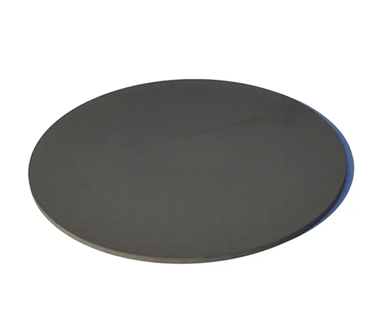Views: 0 Author: Site Editor Publish Time: 2025-05-31 Origin: Site








The semiconductor industry is a cornerstone of modern technology, powering everything from smartphones and computers to automotive electronics and industrial machinery. As semiconductor devices become increasingly complex, with shrinking feature sizes and heightened performance demands, the manufacturing processes used to produce these chips have grown correspondingly sophisticated.
One critical aspect of semiconductor manufacturing is the use of materials that can withstand the harsh environments within processing chambers. High purity, durability, and chemical resistance are paramount to ensure consistent device quality and maximize yield. This is especially true for processes such as etching and chemical vapor deposition (CVD), which involve exposure to reactive plasmas, high temperatures, and corrosive gases.
In recent years, silicon carbide (SiC) coated graphite parts have become the preferred material choice for many semiconductor manufacturers. These components offer a unique combination of thermal, chemical, and mechanical properties ideally suited for plasma and high-temperature environments encountered in etching and CVD equipment.
Etching and CVD are fundamental techniques in semiconductor fabrication, but they subject chamber components to severe operating conditions:
High Temperatures: CVD processes often operate at temperatures exceeding 1000°C to facilitate precursor decomposition and film formation. Similarly, plasma etching chambers heat substrates and chamber parts to maintain process consistency.
Reactive Plasmas and Corrosive Gases: These processes use highly reactive gases such as fluorine (F2), chlorine (Cl2), boron trichloride (BCl3), and sulfur hexafluoride (SF6). The gases, energized into plasma states, bombard chamber surfaces, causing physical and chemical erosion.
Vacuum or Low-Pressure Environment: The vacuum environment necessary for precise process control adds additional constraints on material selection, as materials must maintain integrity without outgassing or deforming.
Semiconductor wafers are extremely sensitive to contamination. Even trace particles or chemical impurities can cause defects that degrade device performance or yield. Therefore, materials used inside processing chambers must:
Exhibit ultra-high purity to avoid introducing contaminants.
Be chemically inert to resist reaction with process gases.
Generate minimal particles and avoid flaking or erosion.
Maintain dimensional stability under thermal cycling to preserve process uniformity.
Traditional materials such as uncoated graphite, quartz, or metals have limitations under these conditions, including rapid oxidation, chemical degradation, or thermal expansion issues.

Graphite is widely appreciated for its excellent thermal conductivity and low thermal expansion coefficient, which are vital for uniform heating of wafers. However, bare graphite oxidizes quickly at temperatures above 400°C in the presence of oxygen or reactive gases, leading to material loss and contamination.
Applying a silicon carbide (SiC) coating dramatically enhances graphite’s oxidation resistance, enabling operation at temperatures above 1200°C without degradation. The SiC layer acts as a protective barrier, blocking oxygen and corrosive species, which significantly extends component lifespan.
The SiC coating provides a dense, inert surface resistant to attack by aggressive fluorine- and chlorine-based plasmas. This chemically inert nature minimizes:
Particle generation: Preventing flaking or erosion reduces particulate contamination inside the chamber.
Chemical reaction with process gases: This protects both the component and the wafer from unwanted chemical interactions.
Surface degradation: Maintains smoothness and dimensional accuracy, crucial for wafer support structures.
SiC coated graphite parts retain graphite’s inherent low density and excellent thermal conductivity while benefiting from silicon carbide’s high hardness and mechanical strength. This combination ensures:
Dimensional stability: Components do not warp or deform during rapid thermal cycling.
Resistance to plasma-induced erosion: The hard SiC surface withstands ion bombardment and mechanical wear.
Mechanical robustness: Components maintain structural integrity under vacuum and stress.
These factors contribute directly to process stability and repeatability, crucial for consistent semiconductor fabrication.
Susceptors are graphite components that support wafers during CVD, providing uniform heating by absorbing RF energy or conduction. SiC coatings protect them from oxidation and plasma attack, ensuring thermal and chemical durability.
Wafer boats hold multiple wafers in batch reactors. SiC coated graphite boats resist corrosion and particle generation, maintaining wafer integrity and spacing.
Fixtures and supports made from SiC coated graphite provide precise, stable positioning of wafers and other parts, critical for process uniformity.
SiC coated graphite liners protect the chamber walls from plasma erosion and corrosive gas attack. Their presence increases chamber life, reduces maintenance frequency, and maintains a clean, contamination-free environment.
Electrostatic chucks (ESCs) are used to hold wafers during processing. The support structures of ESCs require materials that provide electrical insulation, thermal conductivity, and mechanical strength. SiC coated graphite fulfills these multifaceted needs, ensuring reliable wafer clamping and temperature control.
The durability of SiC coated graphite parts reduces the need for frequent chamber maintenance and part replacement. Longer service life means:
Reduced downtime: Equipment spends more time in production.
Lower labor costs: Fewer interventions needed.
Decreased component costs: Less frequent purchases reduce operational expenses.
Consistent thermal profiles, chemical inertness, and dimensional stability contribute to stable process conditions. This stability leads to:
Higher wafer yields: Fewer defects and scrap wafers.
Improved device reliability: Uniform, defect-free layers improve chip performance.
Optimized throughput: Stable conditions allow tighter process control and faster ramp-up.
Semiconductor manufacturing demands materials that withstand extreme conditions, especially in etching and CVD processes involving high temperatures, corrosive plasmas, and vacuum environments. SiC coated graphite parts combine graphite’s excellent thermal conductivity and machinability with silicon carbide’s superior chemical and mechanical resistance, offering contamination-free operation, stable thermal performance, and extended component life. This leads to reduced downtime and higher wafer yields, making them indispensable in modern semiconductor fabrication.
As the industry advances toward smaller, more complex devices, the importance of reliable SiC coated graphite components continues to grow. SIAMC Advanced Materials Co., Ltd. provides high-quality, precision-engineered SiC coated graphite parts tailored to meet these demanding requirements. To enhance your manufacturing process and ensure consistent, cost-effective production, we recommend visiting SIAMC’s website or contacting their team to explore customized solutions that fit your needs.